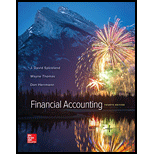
Concept explainers
1.
To compute: The risk ratios of Company GA for the year 2020.
1.
Explanation of Solution
Financial Ratios: Financial ratios are the metrics used to evaluate the liquidity, capabilities, profitability, and overall performance of a company. The risk ratios are as follows:
- a. Receivables turnover ratio: Receivables turnover ratio is mainly used to evaluate the collection process efficiency. It helps the company to know the number of times the
accounts receivable is collected in a particular time period. This ratio is determined by dividing credit sales and sales return.
Determine receivables turnover ratio.
Working Notes:
Determine the amount of average accounts receivables.
- b. Average collection period: This ratio is used to determine the number of days a particular company takes to collect accounts receivables.
Determine average collection period.
- c. Inventory Turnover Ratio: This ratio is a financial metric used by a company to quantify the number of times inventory is used or sold during the accounting period.
Determine receivables turnover ratio.
Working Notes:
Determine the amount of average accounts receivables.
- d. Average days in inventory: Average days’ in inventory is determined as the number of days a particular company takes to make sales of the inventory available with them.
Determine average days in inventory.
- e.
Current Ratio : Current ratio is used to determine the relationship between current assets and current liabilities. Current ratio is determined by dividing current assets and current liabilities. The ideal current ratio is 2:1
Determine current ratio.
Current assets and current liabilities are determined as follows:
- f. Acid-Test Ratio: This ratio denotes that this ratio is a more rigorous test of solvency than the current ratio. It is determined by dividing quick assets and current liabilities. The acceptable acid-test ratio is 0.90 to 1.00. Use the following formula to determine the acid-test ratio:
Determine acid-test ratio.
Quick assets are determined as follows:
- g. Debt-equity Ratio: The debt equity ratio measures the relationship between the capital contributed by creditors and the capital contributed by the stockholders or owners. It indicates the long term solvency position of the company.
Determine debt equity ratio.
Total liabilities and
- h. Times interest earned ratio: Times interest earned ratio quantifies the number of times the earnings before interest and taxes can pay the interest expense. First, determine the sum of income before income tax and interest expense. Then, divide the sum by interest expense.
Determine times interest earned ratio
2.
To compute: The profitability ratios of Company GA for the year 2020.
2.
Explanation of Solution
Financial Ratios: Financial ratios are the metrics used to evaluate the liquidity, capabilities, profitability, and overall performance of a company. The profitability ratios are as follows:
- a. Gross profit ratio: Gross profit is the financial ratio that shows the relationship between the gross profit and net sales. It represents gross profit as a percentage of net sales. Gross Profit is the difference between the net sales revenue, and the cost of goods sold. It can be calculated by dividing gross profit and net sales.
Formula:
Determine gross profit ratio.
Working Note:
Determine the amount of gross profit.
- b. Return on assets: Return on assets determines the particular company’s overall earning power. It is determined by dividing sum of net income and average total assets.
Formula:
Determine return on assets ratio.
Working Note:
Determine the amount of average total assets.
- c. Profit margin: This ratio gauges the operating profitability by quantifying the amount of income earned from business operations from the sales generated.
Formula:
Determine profit margin ratio.
- d. Asset Turnover: Asset turnover refers to the ratio calculated which determines the amount of sales revenue generated by the business with the use of the total assets owned by it.
Formula:
Determine asset turnover ratio.
- e. Return on equity: Return on equity is used to determine the relationship between the net income and the average common equity that are invested in the company.
Formula:
Determine return on stockholders’ equity ratio.
Working Note:
Determine the amount of average stockholders’ equity.
Compute the amount of opening and closing stockholders’ equity.
Want to see more full solutions like this?
Chapter 12 Solutions
Financial Accounting
- i am also posting you can answer my question also you answered my question can i give unhelpful?? You are posting questions and giving unhelpful i am also positing you can give my answer i will not give unhelpful but If you unhelpful my answer then I will unhelpful your answer. Also you know unhelpful will remove after coureshero review. So coperate.arrow_forwardPlease given correct answer for General accounting question I need step by step explanationarrow_forwardCan you explain the process for solving this financial accounting question accurately?arrow_forward
- You are posting questions and giving unhelpful i am also positing you can give my answer i will not give unhelpful but If you unhelpful my answer then I will unhelpful your answer. Also you know unhelpful will remove after coureshero review. So coperate.arrow_forwardWhat is the average price paid by the stockholders for a share of common stock ?arrow_forwardWhat is the total amount of Blake Enterprises' assets after this transaction has been recorded ?arrow_forward

 AccountingAccountingISBN:9781337272094Author:WARREN, Carl S., Reeve, James M., Duchac, Jonathan E.Publisher:Cengage Learning,
AccountingAccountingISBN:9781337272094Author:WARREN, Carl S., Reeve, James M., Duchac, Jonathan E.Publisher:Cengage Learning, Accounting Information SystemsAccountingISBN:9781337619202Author:Hall, James A.Publisher:Cengage Learning,
Accounting Information SystemsAccountingISBN:9781337619202Author:Hall, James A.Publisher:Cengage Learning, Horngren's Cost Accounting: A Managerial Emphasis...AccountingISBN:9780134475585Author:Srikant M. Datar, Madhav V. RajanPublisher:PEARSON
Horngren's Cost Accounting: A Managerial Emphasis...AccountingISBN:9780134475585Author:Srikant M. Datar, Madhav V. RajanPublisher:PEARSON Intermediate AccountingAccountingISBN:9781259722660Author:J. David Spiceland, Mark W. Nelson, Wayne M ThomasPublisher:McGraw-Hill Education
Intermediate AccountingAccountingISBN:9781259722660Author:J. David Spiceland, Mark W. Nelson, Wayne M ThomasPublisher:McGraw-Hill Education Financial and Managerial AccountingAccountingISBN:9781259726705Author:John J Wild, Ken W. Shaw, Barbara Chiappetta Fundamental Accounting PrinciplesPublisher:McGraw-Hill Education
Financial and Managerial AccountingAccountingISBN:9781259726705Author:John J Wild, Ken W. Shaw, Barbara Chiappetta Fundamental Accounting PrinciplesPublisher:McGraw-Hill Education





